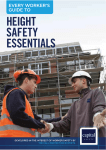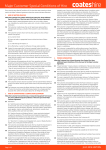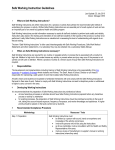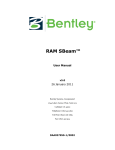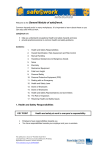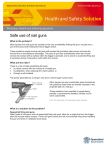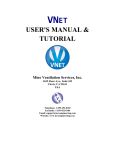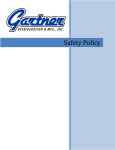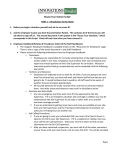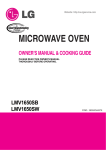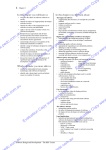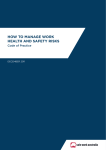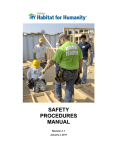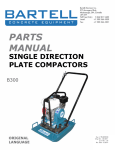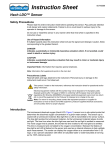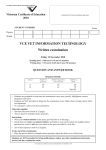Download waste management
Transcript
Waste collection industry Dec 2012 WorkSafe has produced this document to increase awareness of safety issues in your industry and highlight the importance of appropriate systems of work and safety management systems. Please take the time to read the relevant parts of this publication and use the checklists to assist you in improving safety in your organisation. How are people getting hurt in your industry? The most common location of injury is the lower back, followed by shoulders, knees, ankles and hands. The occupations that recorded most injuries are truck drivers followed by recycling and rubbish collectors. Work activities that result in injuries are diverse and relate to trucks, bins and containers, loading plant, traffic and ground surfaces. What is a risk assessment? The occupational safety and health laws require risk assessments to be carried out. A risk assessment is the process of determining whether there is a risk associated with an identified hazard, that is, whether there is any likelihood of injury or harm. The process should include consultation with people involved in the task, as well as consideration of the, experience and training of the operator, individual tasks to be performed and the length of time the operator is exposed to the identified hazards. In the waste collection industry, the most common causes of injury are: • muscular stress while handling objects other than lifting; • falls on the same level; • falls from heights; • being hit by moving objects; and • muscular stress while lifting, carrying and putting down objects. How do I use these checklists? 1. Use the checklists in this newsletter to inspect your workplace. You may see other hazards as you are going through – add them to the checklist. 2. Anything that you have ticked ‘No’ or added to the list needs to be fixed. So, look at each hazard using the table below to prioritise identified hazards. Risk rating table – for working out level of risk Use the vertical and horizontal columns to consider both the likelihood of injury or harm to health and the consequences to work out the level of risk Likelihood of injury or harm to health Very likely Consequences of any injuries or harm to health Insignificant eg no injuries Moderate eg first aid Major eg extensive injuries Catastrophic eg death High Extreme Extreme Extreme Likely Moderate High Extreme Extreme Moderate Low High Extreme Extreme Unlikely Low Moderate High Extreme Highly unlikely (rare) Low Moderate High High Risk assessment is a 'best estimate' on the basis of available information. It is important the responsible person undertaking a risk assessment has the necessary information, knowledge and experience of the work environment and work process, or such a person is involved. 3. If the hazard falls into ‘high’ or ‘extreme’, based on your view of how likely it is someone will get hurt and what level of injury could happen, then you need to fix it straight away. If it is lower down in the table – moderate or low – then plan when you will fix it. Remember hazards have to be controlled – you can’t ignore them. Westcentre 1260 Hay Street West Perth WA 6005 Telephone: 1300 307 877 Facsimile: (08) 9321 8973 Email: [email protected] 2 Recent incidents In the last two years in the solid waste collection industry there have been 13 serious lost time injuries of 60 days or more and 35 lost time injuries of five days or more. • An area of potential risk of injury in the industry is the operation of compacting waste trucks. There have been two recent fatalities, whereby an employee was crushed between his waste truck and a wall and a member of the public was run over by a waste truck while it was reversing. In another incident, a worker received serious injuries after being crushed between the compactor and the tailgate. • • Contributing factors The operation of compacting waste trucks has the potential to expose collection crews, other road users and pedestrians to a range of hazards which may include: • • • • • • • • • • • being struck by compaction truck or other vehicles; being struck by tailgate; crushing by tailgate or crushing in compactor; falls from height; manual tasks; slips trips and falls; sharps and biological waste; fatigue; environmental hazards including extremes of temperature, UV exposure; work near overhead power; and noise. • • • • Reversing causes a disproportionately large number of moving vehicle accidents in the waste/recycling industry, therefore wherever possible reversing should be eliminated or the reversing distance reduced. Where reversing cannot be eliminated, a risk assessment may indicate that the use of reversing aids alone is insufficient to adequately control the risks during reversing. In these circumstances: • • • Action required Under regulation 3.1 of the Occupational Safety and Health Regulations employers have a legal requirement to carry out a risk assessment of their specific activities. This will help: • • • identify the hazards to those potentially at risk (employees, contractors and subcontractors, agency workers, members of the public, etc.); assess the risks from those hazards; and consider the means by which the risks can be reduced. Employers should make themselves aware of any available compacting waste truck safety features which may eliminate hazards or reduce their risk such as: • reversing cameras, audible alarms, lights and mirrors; use of tailgate props (always stay clear of unpropped tailgate); manufacturer’s recommended closing times for tailgates; emergency stops; audible alarms which sound when the driver’s door is opened and the vehicle handbrake is not fully engaged; communication systems between driver and other workers, such as a reversing assistant; speed limiting devices; and safety signage. • • • • trained reversing assistants should be used.; the reversing assistant should stand 5-10 m back and 1 m out from the side of the vehicle, on the pavement wherever possible, so that the driver can see them at all times; where direct eye-contact is not practicable at all times, there should be other means of communication between the driver and the reversing assistant, such as two way radio or mobile phone; reversing assistants should never stand directly behind the vehicle - if the driver loses sight of the reversing assistant they should stop the vehicle at once. people should not be in the crush zone during reversing, i.er between the rear or sides of the vehicle and fixed objects such as walls, lamp posts or cars; reversing assistants should never walk backwards while giving signals (this poses a slip or trip risk) and should be sure the driver can see them at all times; and loading should never take place while the vehicle is reversing. WorkSafe Victoria produced a handbook for safe collection of hard waste in conjunction with industry stakeholders, including waste industry associations, waste and recycling employers, local government and unions. It provides employers, contractors and councils working in the waste collection industry with information on how to safely collect domestic hard waste and bundled green waste. The guidelines apply to collections arranged privately and those provided by councils. They do not apply to the collection of industrial waste, construction waste or scrap metal, but the information may be useful when undertaking this work. This publication is free to download from WorkSafe Victoria’s website: www.worksafe.vic.gov.au 3 Safe movement of vehicles at workplaces Vehicles and mobile plant moving in and around workplaces cause far too many occupational injuries and deaths in WA. Reversing, loading, unloading and pedestrian movements are the activities most frequently linked to accidents. To avoid incidents, traffic and pedestrian movement needs to be designed, planned and controlled. Here are some tips for safe movement of vehicles: • Design traffic routes so they are wide enough for the largest vehicle using them. They should be one-way (if possible) and have clearly signed traffic instructions. • Separate pedestrian footpaths or walkways from traffic or make traffic routes wide enough for both vehicles and pedestrians. Use pedestrian barriers to prevent people walking in front of vehicles. • Situate loading bays where vehicles can be manoeuvred easily and protected from adverse weather conditions. Raised loading platforms should be fitted with rails and raised wheel stop edges on the non-loading sides, to prevent people, forklifts or trolleys rolling over the edge. • Mark reversing areas so drivers and pedestrians can see them easily. To reduce reversing accidents, place fixed mirrors at blind corners. • Ensure that people directing traffic wear high-visibility clothing and that their signals can be seen clearly. Working at HEIGHT Identifying working at height hazards involves recognising situations that may cause injury or harm to the health of a person, such as where a person may fall from, through or into a place or thing. There are a number of ways to identify potential situations that may cause a fall to occur. A hazard identification process or procedure may range from a simple checklist for specific equipment, such as a ladder or fall-arrest system inspection checklist, to a more open-ended appraisal of a group of related work processes. Generally, a combination of methods will provide the most effective results. Key things to check at your workplace • surfaces: unstable, fragile or slippery floors (eg. wet, polished, glazed or oily surfaces); the safe movement of workers where surfaces change; the strength or capability to support loads; and the slope of work surfaces; • levels: where levels change and workers may be exposed to a fall from one level to another when climbing into trucks; • structures: the stability of temporary or permanent structures for accessing the top of waste trucks; • the ground: the evenness and stability of ground; • the raised working area: whether it is crowded or cluttered; • edges: edge protection for open edges of floors, working platforms, walkways, walls or roofs; • hand grip: hand grips are available where hand grip may be lost; • openings or holes: which will require identification or protection; • proximity of workers to unsafe areas: where operators need to access the top of trucks or compactors; where work is to be carried out above workers (e.g. potential hazards from falling objects); and where waste is collected in the vicinity of power lines; • fall injury prevention system: ensuring that harnesses and attachment points are checked regularly and kept in good condition; • movement of plant or equipment: ensuring there is no sudden acceleration or deceleration; • access to, egress from and movement around the working area: checking for obstructions; • lighting: ensure that sufficient lighting is provided, in particular outside daylight hours ; • weather conditions: when heavy rain, dew or wind are present; • footwear and clothing: suitability for conditions; • ladders: where and how they are being used; and • young, new or inexperienced workers: i.e. workers unfamiliar with a task. Manual TASKS • gradual wear and tear - e.g. from frequent or prolonged activities); or form sudden damage - e.g. from a single lift of something very heavy or awkward to handle or from tripping and falling while carrying an object. Strain injuries may occur when: the load is lifted from the floor, or from below mid-thigh height; • reaching above shoulder height to either access items or work for any length of time in this position; • there is too much twisting and bending; • excessive forward reaching is required; • items such as machine parts are too heavy when other risk factors, such as: o the number of times things are moved or the distance moved, are taken into account; and o the items being moved are awkward to grasp due to their size and shape. • Slips trips and falls What risk factors contribute to slips and trips incidents? Slips and trips account for 20% of all lost time injuries every year. They can result in serious injuries and lengthy periods of time off work. Risk factors that contribute to slips and trips injuries will vary according to the type of workplace and tasks being undertaken. Common risk factor categories include: • floor surface and condition; • floor contamination; • objects on the floor; • ability to see floor, walkways, hazards; • cleaning and spill containment; • space and design; • stairs and stepladders; • work activities, pace and processes; • footwear and clothing; and • individual characteristics. Next, in consultation with staff, complete a risk assessment for each task to determine which risk factors are present and identify the level of risk. Risk factors may be actions and postures; forces and loads; vibration; work environment; systems of work; and worker characteristics – please refer to the WA Code of Practice Manual Tasks for more information. Final step • The first step, in consultation with your workers, is to identify the manual task hazards in your workplace. Manual task hazards can be identified by: • reviewing hazard/injury reports; • consulting with workers and safety and health representatives; and • by observing tasks being performed. Second step Injuries can be the result of: How do I reduce the risk of injury from manual tasks? First step Workplace injuries most commonly linked to manual tasks include sprains and strains, hernias and damage to the back. Such injuries are a major cause of lost time at work. Manual tasks is more than just keeping your back straight and knees bent, or lifting properly – it involves safely carrying, pushing and pulling, and holding or restraining. Just as manual tasks involve more than just lifting, the things that affect the risk of injury involve more than just the weight of the objects handled. Factors such as repetitive and/or forceful movements, awkward movements or postures are also very important. 4 Finally, for each hazard, determine what controls are needed to minimise risk. Priority should be given to implementing control measures where the level of risk is moderate, high and extreme. These controls may include, training and supervision and provision of a range of equipment such as: • trolleys; • lift tables; • castors and wheels; • work stands; and • forklifts; • pallet lifters. • hand trucks; What is a safe weight to lift? There is no safe weight. The risk of injury increases as the weight of the load increases. Evaluating the risk posed by the weight of the object needs to take into account: • how long the load is handled; • how often the load is handled; and • the physical characteristics of the individual. How can I reduce the risk of slips, trips and falls in my workplace? There are many controls that employers can use to prevent slips and trips in the workplace. Firstly though, it is important to complete hazard identification and a risk assessment in consultation with workers. This will ensure that the right control is chosen for the hazards that are relevant in the workplace. Common controls used in workplaces can be categorised according to the hierarchy of controls: • Eliminate the hazard - remove slip or trip hazard. • Substitution - install non-slip surface on truck steps and ladders. • Isolation - restrict access to some work areas. • Engineering controls (minimising risk by redesign) - improve lighting, mark walkways, install drainage in truck wash bays, and use ramps instead of steps. • Administrative Controls - ensure good housekeeping - clean up spilled rubbish immediately and use signs for slippery or wet floors. • Personal Protective Equipment – use adequate safety boots. 5 Are you covered by the regulations for driving commercial vehicles? STEP 1 QUESTIONS COMMERCIAL VEHICLE Do you drive a commercial vehicle in the list below: • an item of mobile plant with a GVM of more than 4.5 tonnes ☐ No ☐ Yes • a motor vehicle with a GVM of more than 4.5 tonnes that is designed to carry or is carrying an item of equipment that is integrated (permanently attached) ☐ No ☐ Yes • any other motor vehicle with a GVM of more than 4.5 tonnes that is used to carry goods for hire or reward ☐ No ☐ Yes If you have answered “No” to all of the questions above, you are not covered by the regulations for driving commercial vehicles. There is no need to continue. If you have answered “Yes” to any of the questions above, first calculate your working hours before answering questions relating to total hours of work time per week. STEP 2 CALCULATE WORKING HOURS • How many hours per week do you spend driving or operating the commercial vehicle? • How many hours per week do you spend doing work associated with driving the commercial vehicle? Include items such as driving off-road, loading and unloading, refuelling, checking the load, vehicle maintenance, completing paperwork related to the load and communicating with supervisors or other drivers. • If the commercial vehicle is an item of mobile plant or integrated mobile plant, how many hours per week do you spend operating the plant? • If you carry an item of mobile plant on your commercial vehicle, how many hours per week do you spend operating that plant at a workplace? STEP 3 QUESTIONS TOTAL HOURS OF WORK TIME PER WEEK • Is your total work time more than 60 hours per week? ☐ No ☐ Yes • Is your work time more than 10 hours in any 24 hours period, for more than once per week? ☐ No ☐ Yes • Does your work time include a period from midnight to 5.00am, for more than once per week? ☐ No ☐ Yes If you have at least one “Yes” in this section, the regulations for driving commercial vehicles apply Further reading Codes of practice • • • • • • • • Manual tasks Prevention of falls at workplaces Fatigue management for commercial vehicle drivers Working hours First aid-workplace amenities-personal protective clothing Safeguarding of machinery and plant Control of work-related exposure to hepatitis and HIV (blood-borne) viruses [NOHSC:2010(2003)] Guidance notes • • • • • • • • • Alcohol and other drugs at the workplace General duty of care in WA workplaces Isolation of plant Plant in the workplace Powered mobile plant Preparing for emergency evacuations Prevention of carbon monoxide poisoning Safe movement of vehicles Working alone Other publications • • Staying alert at the wheel Safety tips for new and young workers and their employers Sun SAFETY Truck drivers are at risk of sun related injuries due to the nature of the work. Implementing a comprehensive sun protection program, which includes a range of protective measures, can prevent sun-related injuries and reduce the suffering and costs associated with skin cancer. Skin cancer and outdoor work A guide for employees is a valuable guide and is available from the Cancer Council website www.cancercouncilwa.asn.au 6 Checklists Manual tasks safety checklist check yes no n/a In consultation with workers, all hazards in relation to manual tasks have been identified and reported hazards have been investigated Risk assessment of potentially hazardous manual tasks have been conducted, including all relevant risk factors such as postures, repetitive movements, forces, duration and frequency of tasks, and environmental conditions. Consider: • getting in and out of the truck • are bins manually collected or moved to truck - check distances, inclines, obstructions • is content of small bins decanted into larger bins • picking up bags of rubbish manually, spilt rubbish, sorting through rubbish • posture while removing blockages from hopper • posture while using tools or high pressure water when cleaning truck • ergonomics in the cab: controls, monitors, sufficient workspace, seating Practicable control measures have been implemented and maintained to eliminate or reduce manual task risk after consulting workers, such as: altering the workplace environment, design or layout; changing the systems of work; modifying the load being handled; changing the tools used to do the task or using mechanical aids. Consider: • grab rails and adequate steps (three points of contact available) • bins on wheels, use of trolley , use of smaller vehicle • limit or avoid decanting of bins • implement work procedures to limit the manual handling of rubbish • crush a bin if it falls in the hopper (preferred option) or return to the depot to remove the bin in a controlled environment • adequate tools are used to remove blockages in the hopper • well-designed wash bays / access for cleaning purposes • well-designed controls and monitors in truck and controls and seat maintained Everyone exposed to hazardous manual task hazards have been provided with adequate instruction and training (induction and ongoing training) Suitable mechanical aids are provided where necessary e.g. suitable trolleys, pallet jacks, forklifts and other (lifting) equipment Trolleys and other mechanical aids are suitable for the job and are well maintained Manual tasks-lifting Lifting is the single most common cause of manual task related injury in Western Australia. On average, workers with injuries from manual tasks take the longest time to recover and return to work. The weight of an object is only one of many factors to consider in avoiding injuries. Other things to take into account include: how often and how quickly a task is performed; the age and physical strength of the person; and the size and shape of the object. Workplace injuries most commonly linked to manual tasks include sprains and strains, hernias and damage to the back. Injuries can be the result of gradual wear and tear from frequent or prolonged lifting or sudden damage from a single lift of something very heavy or awkward. Code of practice MANUAL TASKS Copies are available to download from the WorkSafe website www.worksafe.wa.gov.au 7 Working from heights safety checklist check yes no n/a Hazard identification and risk assessment of falls has been conducted – consider risk factors to tasks such as access in and out of the truck and access to the top of the truck, hopper or compactor Practicable control measures have been implemented and maintained to eliminate or reduce the risk associated with work at heights. Consider the following: • • • height of first step of truck, width and tread on step, grab rails, three points of contact for access to top of truck use scaffold, portable platform ladder, fall-arrest system or install railing on top of trucks, etc. no riding on rear or side of truck Edge protection is required if a person could fall more than 2 metres from a scaffold, fixed stairs, landing, suspended slab, formwork, or false work In any other case greater than 3 metres: fall injury prevention systems (e.g. catch platform, scaffold, safety nets, safety mesh, or fall-arrest system) or edge protection are provided There is safe means of access and egress to the work being performed at heights Stairs, walkways, ladders, mechanical lifts etc. are free of obstructions People required to work at height have been provided with adequate information, instruction and training for the work being performed Working from heights In Western Australia an average of two workers die each year after falling. Most of these falls occur from relatively low heights i.e. less than five metres. A further five people are killed by falling objects. Many more suffered serious injuries. Workers falling from ladders, stairs or scaffolding are typical accidents and the most common types of injuries are sprains and strains, fractures and bruising. Slips trips and falls safety checklist check yes no n/a Floor or any stair or ramp has an unbroken and slip resistant surface Floor or any stair or ramp is free from any obstruction that may cause a person to fall (e.g. electrical leads, hoses, tools and floor mounted power boxes in walkways, etc.) Access to egress from workplace safe and kept free from obstructions at all times Safe systems are in place to ensure that the floor is free from fall hazards / obstructions Warning signs available and erected near spills Guard rails or other safeguards are provided on ramps and stairs Appropriate protective equipment, such as slip resistant footwear, is required Ramps are available in areas where height of floor levels change and trolley access is required or items are carried regularly Slips, trips and falls Slips, trips and falls are a significant problem affecting every workplace, from factory floor to office. People who work near concrete surfaces face the greatest risk of suffering an injury from slipping or tripping. Factors that contribute to the risk of slips and trips include: • unstable, loose, or uneven floor surfaces; • obstacles blocking walkways; • slippery floor surfaces from spilt substances, e.g. fluid, mud or oil; • types of flooring or surface texture, such as wood, concrete or vinyl; • inadequate lighting; and/or • inadequate footwear 8 New and young workers safety checklist check yes no n/a Information, instruction and training on hazards at the workplace has been provided to new and young workers Staff capabilities are assessed and where applicable a training plan is developed and agreed by both parties Information, instruction and training in emergency and evacuation procedures has been provided Information and training in hazard and accident reporting has been provided Information, instruction and training on the prevention of drugs and alcohol use at the workplace has been provided Information, instruction and training on the prevention of bullying and violence at the workplace has been provided Information, instruction and training in the use, maintenance and storage of personal protective equipment has been provided Trainees and apprentices are under constant supervision Employers ensure the risk of injury or harm to visitors is reduced by means appropriate for the workplace and the type of work activity – e.g. visitors are accompanied in the workplace Infectious diseases and viruses safety checklist check Safe work procedures are in place including: • standard precautions • appropriate handling of used needles, sharps and syringes • avoid direct contact with waste, including spilled rubbish and waste contaminated with body fluids, unless using appropriate personal protective equipment • use of appropriate personal protective equipment • immediate first aid response after needle stick and sharps incidents or exposure to blood and body fluids to broken skin or mucous membranes Standard precautions to reduce the risk of acquiring infections include good hygiene practices such as hand washing after handling waste, care of intact normal skin, protection of damaged skin, the use of personal protective equipment, appropriate handling and disposing of sharps and syringes, regular cleaning of work areas, etc. Impermeable sharps container for the disposal of sharps and needles is provided and used Employees have received training in relation to infectious diseases and viruses. Training includes: • information on and risk of contracting infectious diseases and viruses • safe work procedures including standard precautions • appropriate handling of needles, sharps and syringes • handling and avoiding direct contact with waste, including spilled rubbish and waste contaminated with body fluids • use of appropriate personal protective equipment • immediate first aid response after needle stick and sharps incidents or exposure to blood and body fluids to broken skin or mucous membranes Employees at risk are encouraged to receive vaccinations such as hepatitis B, tetanus, etc. yes no n/a 9 Pre Start – truck and compactor safety checklist check yes no n/a Pre start checks are conducted in accordance with the manufacturer’s instructions The manufacturer’s instructions are available and accessible to the operator for the each item of plant, including the truck and the compactor Systems are in place for reporting defects on plant such as the truck and the compactor Operation - truck and compactor safety checklist check yes no n/a When a bin falls in the hopper, systems are in place for crushing the bin. When a bin needs be removed from the compactor, this is done in a safe environment (e.g. depot) and hazards relating to manual tasks, working at heights, falling into hopper and being crushed are controlled. Overweight bin should not picked up as there is an increased risk the bin may fall into the compactor while being emptied Overhead power lines • adequate training provided including risk of tyre pyrolysis • bins placed in an area away from power lines • warning provided with job information i.e. on job screen • signage on bins located close to power lines Council have assessed collection point of bins and taken into account factors such as accessibility to the bins, traffic management , street conditions, need to reverse, etc. External flashing beacons operational during loading and unloading In-cab monitors, beepers, warning lights, cameras, etc. are used and in good condition Hand break alarm is present and linked to the driver’s door Communication is in place with immediate co-worker and depot Adequate lighting and/or spotlights for working outside daylight hours are available Traffic management, including safe movement of vehicles and segregation of the public and trucks is in place at transfer station or landfills Consider communication , signage / speed / procedures Safe movement of vehicles including the segregation of pedestrians and trucks is in place at the depot Cleaning – truck and compactor safety checklist check Systems are in place to safety remove blockages Cleaning of compactor tailgate is done by the driver If another person cleans the rear door seal, safe systems are in place, such as adequate procedures, training for all persons involved, direct eye contact with driver, adequate communication between the driver and the person cleaning the rear seal (e.g. radio contact) and cleaner stands away from the rear door Safety props are engaged when the person cleaning the seal is likely to work under the open tailgate (e.g. when using a broom to clean the rear door seal) If any tools are used for cleaning, such as brooms, consider the risk of manual task injuries and falls from heights Cleaning procedure for the compactor is in place, including a system for isolating the plant Ensure the compactor cannot be operated, by locking out the plant i.e. keys are kept with the operator Rear door closing time is regularly checked as part of the maintenance program and is more than 20 seconds Rear door props are used as required when anyone is under the open tailgate Safety props are in working order i.e. not cable tied or bolted to the vehicle yes no n/a 10 Confined spaces safety checklist check yes no n/a If workers need to enter a confined space , this is done in a controlled environment: • risk assessment has been conducted ( dust, fumes, mist, vapours, gas, etc.) • training has been provided • work is done in accordance with AS2865 • provision is made for another person to be present Guarding and signage safety checklist check yes no n/a Guarding of moving parts on the compactor (i.e. hydraulic arms) is in place Signage (decals) in accordance with AS1319 is in place and is legible, i.e. in relation to crush hazards, use of safety props, keep clear, beware of overhead power lines, etc. Personal protective equipment safety checklist check yes no n/a Personal protective equipment has been provided, including steel capped boots, gloves, eye protection, high visibility clothing, heatstroke and sun protection (long sleeve shirt , trousers , hat and sunscreen) , hearing protection if required and respiratory equipment if required Personal protective equipment is provided without any cost to workers Training has been provided in relation to the selection, instruction, fitting, use, maintenance ,storage of personal protective equipment as per AS2161.2 Electricity safety checklist check Work in the vicinity of overhead powerlines Work in the vicinity of power lines and plant must be controlled – ensure designated pick-ups are clear of overhead powerlines , consider place of bins, type of waste collection truck, placing stickers on bins to remind operators of the vicinity of overhead powerlines Electrical installations The work is organised for the safety of workers and others in the workplace – consider electrical safety of workshop, cleaning bays, etc. Electrical installations are installed, constructed, maintained, protected (cover on switchboard) and tested to minimise the risk of electric shock or fire Evidence of maintenance and testing of electrical installations is available Components on switchboard are clearly marked Switchboards are kept free from obstructions Residual Current Devices (RCDs) Hand held or portable equipment is protected by RCDs installed at the switchboard or into a fixed socket Switchboards or fixed sockets have signage to indicate they are RCD protected A RCD maintenance program is in place Flexible cords, plugs, sockets and extension leads Flexible cords and extension cords are used in a safe manner Plugs, sockets and extension leads are in good condition and protected from damage yes no n/a 11 Hazardous substances safety checklist check yes no n/a Asbestos waste and asbestos containing materials Employees have been trained in recognising asbestos waste materials Any asbestos waste material is disposed of in accordance with Part 11 of the Code of Practice for the Management and Control of Asbestos in Workplaces [NOHSC: 2018 (2005)] The presence and location of asbestos at the workplace (depot) has been identified Where asbestos has been identified, an assessment of risks has been conducted in accordance with the Code of Practice for the Management and Control of Asbestos in Workplaces [NOHSC:2018 (2005)] Asbestos register is available and used at the workplace where asbestos has been identified Where an asbestos register is present at the workplace, relevant persons have received information and training on the contents and use of the asbestos register Register of hazardous substances A register of hazardous substances is available and accessible for workers likely to be exposed to hazardous substances at the workplace The register of hazardous substances is complete – the register includes a contents list and current Material Safety Data Sheets (MSDS) The register of hazardous substances is current – MSDS are not older than 5 years Labelling Hazardous substances are properly labelled – e.g. containers are labelled with manufacturers labels that are complete and legible Chemicals decanted into other containers are labelled with name, risk and safety phrases Empty food or beverage bottles are not used to store chemicals Risk assessment and control Risk assessments have been completed for all hazardous substances.– when conducting a risk assessment, consider how the substances is used, where it is stored, is ventilation required, are directions in the MSDS followed, what personal protective equipment is required. A record is made in the hazardous substances register that the assessment has been done A risk assessment report is available where the risk is significant Practical control measures have been implemented and maintained taking into account the hierarchy of control Information, instruction and training Workers who may be exposed or work with hazardous substances have been provided with adequate information, instruction and training A record of the training is kept and includes health effects, controls, safe work methods, personal protective equipment and where applicable health surveillance Other issues safety checklist check Reportable accidents have been notified to WorkSafe Lost time injuries or diseases, accidents and notified hazards have been investigated Portable fire extinguisher(s) is provided, maintained and mounted in the truck Employees are trained in the use of a fire extinguisher First aid equipment is supplied Drinking water is available Air temperature and heat stress are controlled, i.e. air conditioner is working in the truck No smoking in the workplace or truck A4808769 yes no n/a












